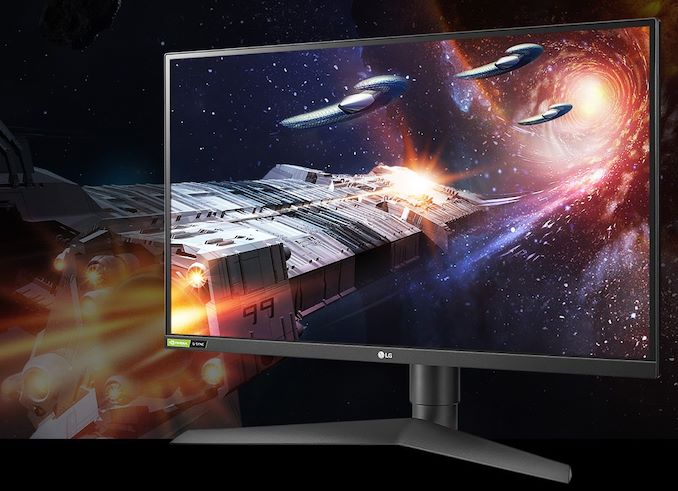Need for Speed: The LG UltraGear (27GN750) 240 Hz IPS Monitor with G-Sync
by Anton Shilov on September 11, 2019 11:30 AM EST
LG has expanded its family of UltraGear displays aimed at hardcore and esports gamers. The newest model, the UltraGear 27GN750, supports a 240 Hz maximum refresh rate as well as NVIDIA’s G-Sync variable refresh rate technology. The LG UltraGear 27GN750 is the industry’s first IPS monitor featuring such a high refresh rate along with the G-Sync technology.
Based on the so-called ‘fast IPS’ 27-inch panel, the LG UltraGear 27GN750 has a 1920×1080 resolution, 400 nits brightness, a 1000:1 contrast ratio, 178°/178° viewing angles, a 1 ms GtG response time, and a variable refresh rate of up to 240 Hz supported by NVIDIA’s G-Sync technology. Unfortunatelly, LG does not disclose the range of the VRR supported by the LCD.
The 27-inch gaming monitor can display 16.78 million of colors and can reproduce 99% of the sRGB color space. Furthermore, it also carries VESA’s DisplayHDR 400 badge and therefore supports HDR10 transport.
Because LG’s UltraGear monitors are designed predominantly for gamers, they support numerous features aimed at this audience, including LG’s Dynamic Action Sync mode, Black Stabilizer, and Crosshair.
As far as connectivity is concerned, the LG UltraGear 27GN750 has one DisplayPort, two HDMI inputs, as well as a dual-port USB hub.
| The LG UltraGear Display with a 240 Hz Refresh Rate | ||
| UltraGear 27GN750 | ||
| Panel | 27-inch class IPS | |
| Native Resolution | 1920 × 1080 | |
| Maximum Refresh Rate | 240 Hz | |
| Dynamic Refresh | Technology | NVIDIA G-Sync |
| Range | ? | |
| Brightness | 400 cd/m² | |
| Contrast | 1000:1 | |
| Viewing Angles | 178°/178° horizontal/vertical | |
| Response Time | 1 ms GtG | |
| Pixel Pitch | ~0.27675 mm² | |
| Pixel Density | ~82 PPI | |
| Color Gamut Support | 99% sRGB | |
| Inputs | 1×DP 1.2 2×HDMI 2.0 |
|
| Audio | headphone out | |
| Stand | ? | |
| Warranty | ? years | |
| MSRP | ? | |
Being one of the leading makers of high-end displays and offering hundreds of models, LG introduced its separate UltraGear brand targeted at demanding gamers only in mid-2019, somehow later than its competitors. The addition of the rather unique (as of today) UltraGear 27GN750 featuring a 240 Hz refresh rate enables the company to address a new market segment of gamers that require maximum performance yet demand quality of an IPS panel. In fact, this is the world’s second IPS LCD featuring a 240 Hz refresh rate and its only competitor is Dell's Alienware 27 model AW2720HF.
Related Reading:
- Fast & Furious: The Alienware 27 (AW2720HF) 240 Hz IPS Monitor with FreeSync
- LG Unveils 27 and 37.5-Inch IPS Monitors with 1 ms Response Time
- LG to Demo UltraWide 38-Inch 144Hz Gaming & 49-Inch Workstation Displays at CES
- LG Unveils UltraGear 34GK950 34-Inch Curved Gaming Displays with Nano-IPS
Source: LG











26 Comments
View All Comments
mobutu - Wednesday, September 11, 2019 - link
and leftjstein - Thursday, September 12, 2019 - link
There's no way you left before posting this commentDanNeely - Wednesday, September 11, 2019 - link
I know. How dare they make a monitor that doesn't cater to your personal preferences of resolution, DPI, and refresh rate. /smode_13h - Friday, September 13, 2019 - link
How dare he voice an opinion against a product with specs he doesn't like. /sinighthawki - Wednesday, September 11, 2019 - link
Same here. I was excited for a moment. Latest gen IPS panels have had really good response times, so I wouldve strongly considered this over the upcoming 240hz tn panels. But 1080p is a deal breaker. 1440p for me.Hope someone finds value in this monitor, not for me though.
mode_13h - Friday, September 13, 2019 - link
TBH, I don't really even see the point of 240 Hz. I get why people want > 60, but how much are you really getting above 120 Hz? Is the main benefit really just for better-quality motion blur? Don't try to tell me the latency difference is perceivable.Beaver M. - Thursday, September 12, 2019 - link
Yep, 1080p on a 27" monitor is pretty useless.blzd - Wednesday, September 11, 2019 - link
Do these "fast IPS" sacrifice image quality to obtain these pixel response times?Any loss in colour or introduction of artifacts I wonder? My first gen 120Hz TN panel suffers from reverse ghosting due to all the pixel over drive to get to 1ms for example.
Guspaz - Wednesday, September 11, 2019 - link
They get pretty fast without ghosting (but not really fast enough for 240hz to be realistic, at least on their 1440p144 monitor), and have good colour accuracy with a decent gamut. Their main shortcoming appears to be below average contrast ratios, like 800:1 or 850:1.Alistair - Wednesday, September 11, 2019 - link
I bought the GL850, and yes the contrast is pretty low, but if you have no backlight bleed (like I do) it ends up being better anyways. One downside. But wow, the colours are amazing, and most importantly for me, this is the VERY FIRST gsync and freesync monitor that I've ever bought that has zero issues. It works amazingly well, even with windowed mode on.Shimmering, flashing, blanking, screen tearing, nope. PERFECT freesync and gsync so far. I can't say what a massive improvement the gsync is with this monitor vs my PG279Q. I actually leave Gsync on now.